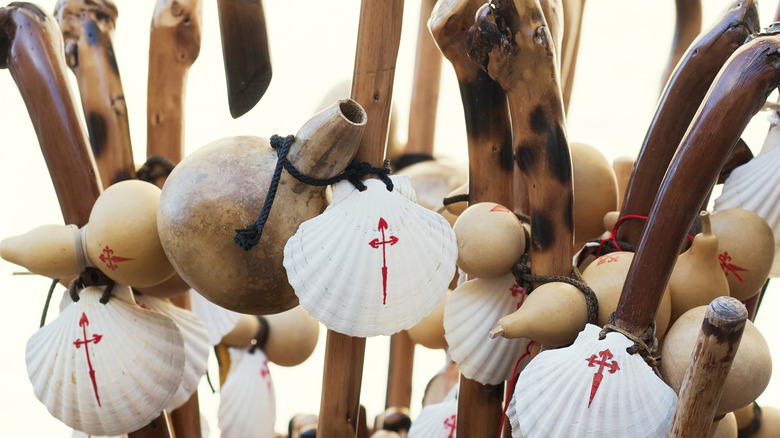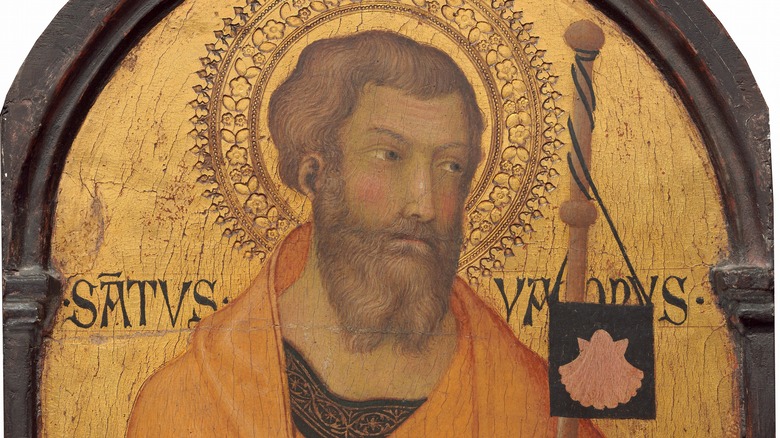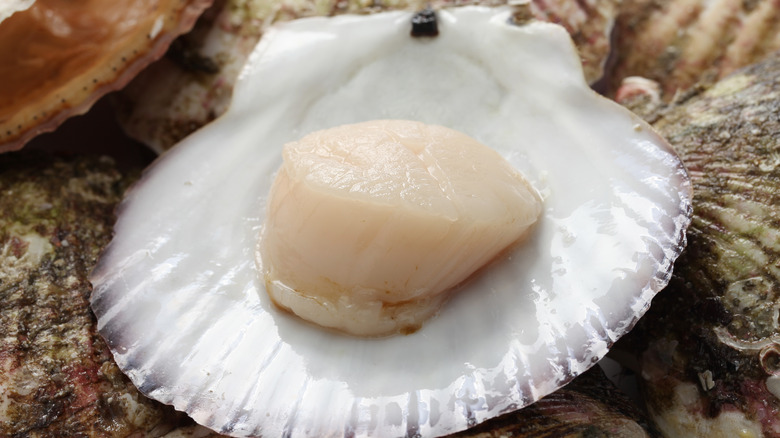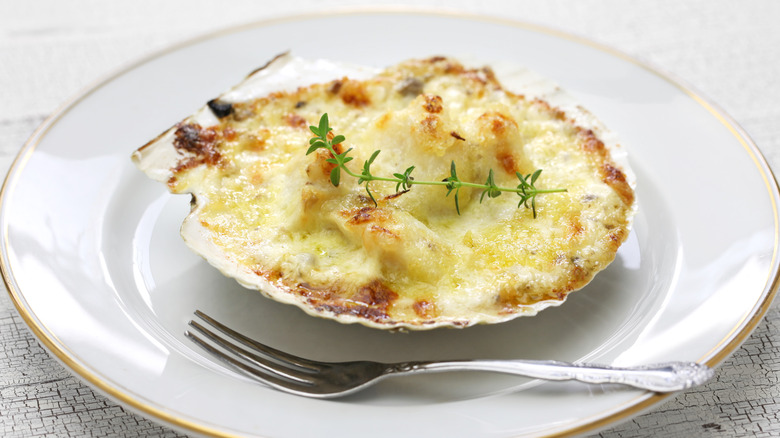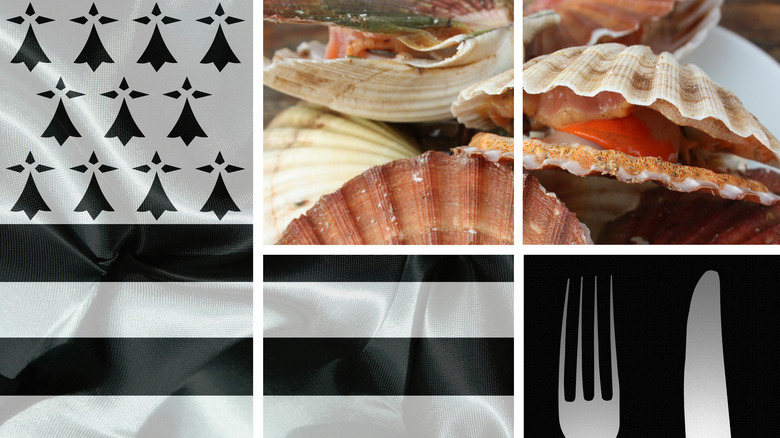The French Scallop Named For A Saint
No one who loves seafood can be complete in their affections without having eaten their fair share of scallops. These beautiful mollusks are considered something of a luxury. They're not exactly cheap — the national average is currently $13.99/lb, per NOAA Fisheries – meaning they are a bit of a special treat. Scallops are shellfish, closely related to clams, mussels, and oysters. They're also something of a superfood, rich in vitamin B12, omega-3 fatty acids, magnesium, potassium, and DHA, which can help prevent cognitive decline (via Simply Healthy Family).
There is, however, a particular breed of scallop that brims not only with flavor, but with cultural, culinary, and religious significance. Anyone familiar with the Camino de Santiago de Compostela will know the symbolic significance of the scallop shell. According to Portugal A2Z, pilgrims walking the camino used to be guided by stone pillars marked with images of scallop shells. These are used as guides so pilgrims know they're headed in the right direction. And now, modern day pilgrims wear scallops on their backpacks or around their necks, as in medieval times, as a symbol of reassurance on the long walk across Spain.
The name for these special scallops goes hand-in-hand with the destination of the Camino: The cathedral of Santiago de Compostela, Saint Jacques de Compostelle in French, per Brittany Tourism, which rests upon the tomb of Saint James the Greater, an apostle of Christ (via Camino de Santiago).
Who was St. James (Jacques)?
Saint James the Greater, known in France as Saint Jacques, is a canonized saint in the Catholic Church and one Christ's first disciples. According to Catholic Online, James was one of only three disciples to witness Jesus's Transfiguration. After the crucifixion and Christ's Ascension, James traveled from Jerusalem, across the Roman Empire, to Spain, then called Iberia, where he spread the Gospel for almost 40 years.
The origins of the camino in James's name began with his martyrdom. As Yonne Compostelle explains, James returned to Jerusalem following his years in Spain and was subsequently killed. His body was brought back to Spain, where he was buried. Saint James's tomb was thought lost for several centuries, until by divine revelation, a Spanish hermit discovered his burial place in 831 A.D. This led to the development of the Compostela and it's destination as a holy sight.
This pilgrimage of Saint James has remained popular for Christians and spiritual seekers for over 1,000 years, despite several occasions upon which the city has been leveled by invading forces. It's from this background that our humble scallop takes its name and religious significance.
Noteworthy characteristics of the Saint Jacques scallop
Coquille Saint-Jacques des Côtes-d'Armor, otherwise known as King Scallops, via Taste Atlas, are a specialty of northwestern France. The scallops thrive the chilly waters of the Bay of Saint Brieuc, where water temperatures average between 53 to 62 degrees during the October to May fishing season (via Brittany Tourism). According to Snippet of Paris, these scallops reach their peak freshness around Christmas. The French value the Saint Jacques scallop as a tasty wintertime treat, owing no doubt to their creamy texture and salty sweet flavor, per Taste Atlas.
Like several treasured culinary items in France, the Saint Jacques scallop is a certified authentic shellfish, making it the first of its kind to receive such recognition by the French government. According to Côtes-d'Armor.com, the high quality of the meat, along with the iconic, ribbed shells, are what make the Saint Jacques scallop so special. The certification also has to do with where the scallops are fished. The scallops are fished at the ports of Erquy and Saint-Quay-Portrieux, both of which sit on the shore of the Bay of Saint-Brieuc, which is the largest natural scallop bed in all of France.
Certified Saint Jacques scallops can only be fished from this area, where there are strict regulations in place to help ensure their longevity.
Dishes for the Saint Jacques scallop
The beauty of this scallop is that it can be eaten raw or cooked. According Côtes-d'Armor.com, the Saint Jacque scallop can be eaten as a carpaccio. Like a beef or lamb carpaccio, the scallops are flavored lightly with lemon juice, salt, and pepper, and refrigerated for one hour before serving to let the flavors sink in. This is a very gentle method of "cooking." As in making ceviche, the acidity of the lemon will denature the protein of the scallop, but not enough to lose its natural, fresh marine flavor (via Serious Eats).
This scallop is a very versatile shellfish in that it aligns itself to a number of cooking methods. Perfectly Provence recommends cooking them in a broth of white wine and mushrooms. You could also add them to a gratin, severed with butter, or baked in the oven with a coating of cheese, per Taste Atlas. The top-rated Aux Pesked restaurant in Saint-Brieuc puts a luxurious twist on these scallops, serving them in their shell with salted butter, herbs, and caviar (via Brittany Tourism).
Of festivals and knights
Europe has no shortage of festivals, and France is no exception. Holland may have its celebration of the New Catch Herring, but at the Côtes d'Armor of northern France, it's all about the scallops. According to Brittany Tourism, the Fête de la Coquille Saint-Jacques is held for two days in April. The festivities are centered around the infamous scallop, but there is also music, tours of the harbor to watch the fisherman as they work to harvest some of the last scallops of the season, and a parade of the Knights of the Scallop.
These Knights are members of a fraternal brotherhood known as the Brotherhood of Scallop Knights of the Côtes-D'Armor, whose purpose is to promote, protect, and honor this famous bivalve of the Côtes d'Armor. The ranks of the Brotherhood include everyone from the everyday scallop enthusiast to French film star Gérard Depardieu (via Vice).
From the annals of history, to pilgrimages across Spain, to the promotion of a way of life cherished by the residents of coastal Brittany, the Saint Jacques scallop is a mollusk that will no doubt continue to hold cultural and religious significance for decades to come.
